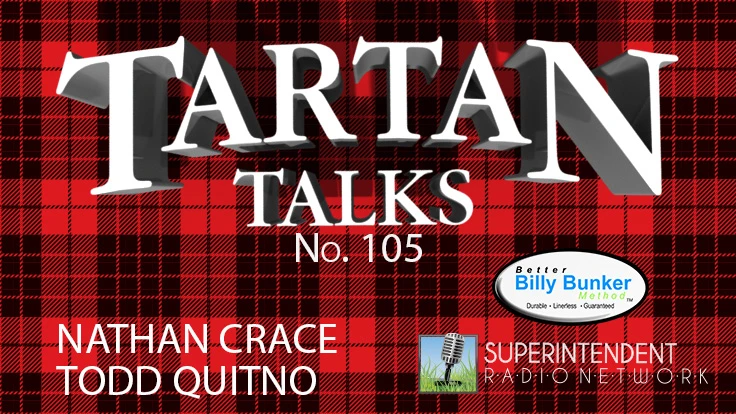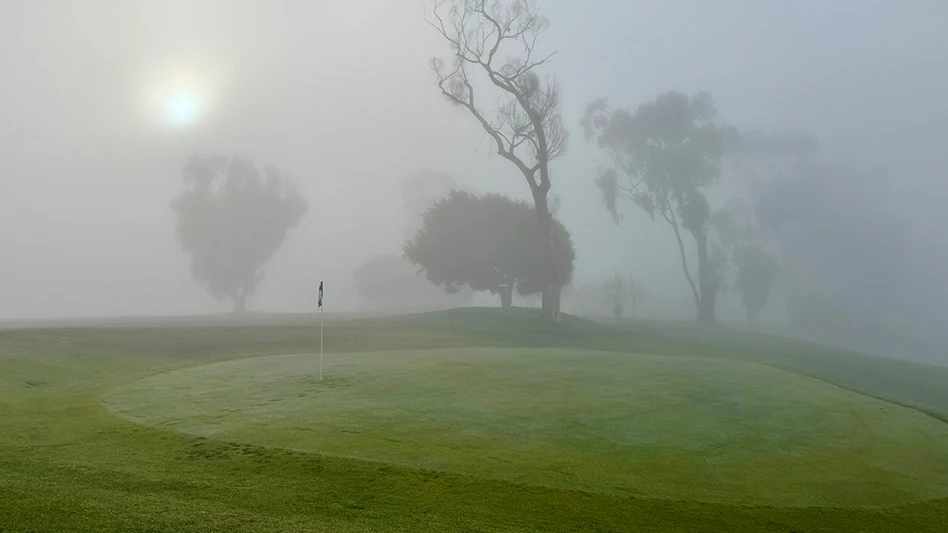As soon as the cool, damp weather moves in each fall, golf course superintendent Ryan Freed knows he’s likely to see more Poa annua on the 10-year-old course he manages.
Freed, in his sixth season at Regent’s Glen Country Club in York, Pa., has learned to expect Poa and has worked out a way to treat and suppress it. Like Freed, many golf course superintendents view the plant as an unwanted nuisance.
|
|
The name Poa annua, or annual bluegrass, can be misleading, says Ron Calhoun, environmental turfgrass specialist at Michigan State University. Annual bluegrass overwinters and oversummers, he says, adding that it doesn’t die like annuals do.
“In this way, it demonstrates more as a perennial because there aren’t conditions to completely knock it out,” Calhoun says.
Some treatments, including preemergent herbicides, are used widely to suppress the growth of the plant, which is often viewed as a weed.
“The rub is that preemergent herbicides aren’t perfect,” Calhoun says. “You’ll maybe get 95 percent control.”
For instance, if there is 2 percent of the Poa left after treatment, an additional 3 or 4 percent will grow the next year. This can continue each year with any Poa that germinates and survives. After three years, Poa can proliferate to represent as much as 15 percent of the turf, Calhoun says.
Calhoun was part of a six-year study in which only preemergents were applied to the bluegrass. After the six years, some of the plots had as much as 35 percent annual bluegrass.
“The percent that remains grows, plus additional plant populations are introduced,” Calhoun says.
Calhoun says the preemergent approach is more effective in the South because warm-season grasses are more competitive than cool-season grasses. Warm-season grasses are more likely to die out after producing seeds because the conditions are harsher.
PGRs as part of the equation
For course with cool-season grasses, Calhoun recommends encouraging bentgrass growth during the time of year when it grows best. In the northern climates, Poa has an advantage growthwise in the spring and fall. Therefore, Calhoun recommends encouraging the growth of bentgrass during the summer. He also recommends running the irrigation system a bit on the dry side.
Freed says plant growth regulators are one of his best tools and uses them amid warm temperatures to encourage his L-93 and Southshore bentgrasses to choke out the bluegrass. He starts a PGR application in the spring and continues it every two weeks until the fall. He doesn’t use preemergents as a regular regimen; instead, he spot-treats with them when needed.
In the South, superintendents find it helpful to use plant growth regulators such as Cutless and TGR – products that can reduce the growth of Poa more than they reduce the growth of bentgrass.
It’s best to apply the PGRs during the summer, Calhoun says.
“With Cutless and TGR, we see injury on Poa when we apply it in the fall and spring,” he says. “But we also realized that was a time when bentgrass wasn’t growing very fast. Then there was some work in Kentucky where they were making applications throughout the whole growing season. In the summer, you can reduce the growth of the Poa more than the bentgrass.”
Postemergent developments
Until recently, preemergent herbicides and PGRs almost have been superintendents’ only means to defend against the bluegrass. Now there are postemergent herbicides that can further help to block out the bluegrass.
“That’s what we’ve been missing in the North,” Calhoun says, mentioning one he’s worked with, Valent’s Velocity. “Their product has a safety on creeping bentgrass and activity on bluegrass. Put these together with cultural, preemergent and postemergent control for an effective program.”
Calhoun says he’s tried to put together a program in the past, but now adding the postemergent to the program makes a noticeable difference.
Even with the postemergent, eliminating bluegrass still isn’t a small undertaking, Calhoun says. Annual bluegrass produces a lot of seed. To add to that, new populations of bluegrass spring up when turf dies from a disease, traffic or water stress.
“The will of the superintendent is outlasted by will of the Poa,” he says.
Sometimes, successfully ridding putting greens of Poa involves hand picking, but that can be labor-intensive. If a superintendent leaves, if there’s course construction, or if the superintendent isn’t paying as much attention to the Poa, the population can quickly shoot up to as much as 12 percent on greens.
Spotting Poa annua
The first golf course Calhoun worked at, the superintendent showed him all the Poa spots on the course and set about to remove them. He had someone come to remove the Poa, but the superintendent, having been at the course for so long, had mixed up the Poa and the bentgrass. After the Poa removal, only the small bentgrass spots, which the superintendent originally thought were Poa, remained.
“People say they want to remove Poa until they see what it really looks like,” Calhoun says. “And then they run the other way.”
Freed, who says the Poa annua on the course he maintains is manageable, advises similarly.
“Know what grass you’re killing and how much you have of it,” he says.
It’s more difficult to detect the bluegrass on greens, so Calhoun says to look for a color difference, and on the fairway, look for a texture difference.
After the preemergents and plant growth regulators have been applied, a postemergent such as Velocity can help knock out that last 15 percent of Poa, Calhoun says. If there’s only 1 to 3 percent of Poa left, it can be removed without too much difficulty.
Freed tested Velocity on his course about three years ago, before it was made available in 2005. Yet he faces another enemy on his fairways: Poa trivialis, or rough bluegrass. He found Velocity was effective in stamping out this variety, especially when applied in warmer temperatures. However, Freed didn’t apply the herbicide this year because the temperatures didn’t go high enough in June when he wanted to use it. He advises fellow superintendents to check with peers to see what works for them. He and Calhoun recommend not jumping into any program without checking first.
“I like to tell people to proceed with caution,” Calhoun says. “It’s like when you’re using a stain on a piece of furniture: Try it first on a small, inconspicuous part of project first. I call it the Minwax approach.”
First try the treatment on a part of the course where you can put a sign and let people know what’s going on, he says. And start the process before Poa management becomes too mammoth a task.
“You don’t want to wait until you have 40, 50, or 70 percent bluegrass,” Calhoun says. “At that point, you might just want to use Roundup and start over.” GCN

Explore the September 2006 Issue
Check out more from this issue and find your next story to read.
Latest from Golf Course Industry
- Beyond the Page 65: New faces on the back page
- From the publisher’s pen: New? No way!
- Indiana course upgrades range with synthetic ‘bunkers’
- Monterey Peninsula CC Shore Course renovation almost finished
- KemperSports and Touchstone Golf announce partnership
- PBI-Gordon Company hires marketing manager Jared Hoyle
- Mountain Sky Guest Ranch announces bunker enhancement project
- GCSAA names Joshua Tapp director of environmental programs






